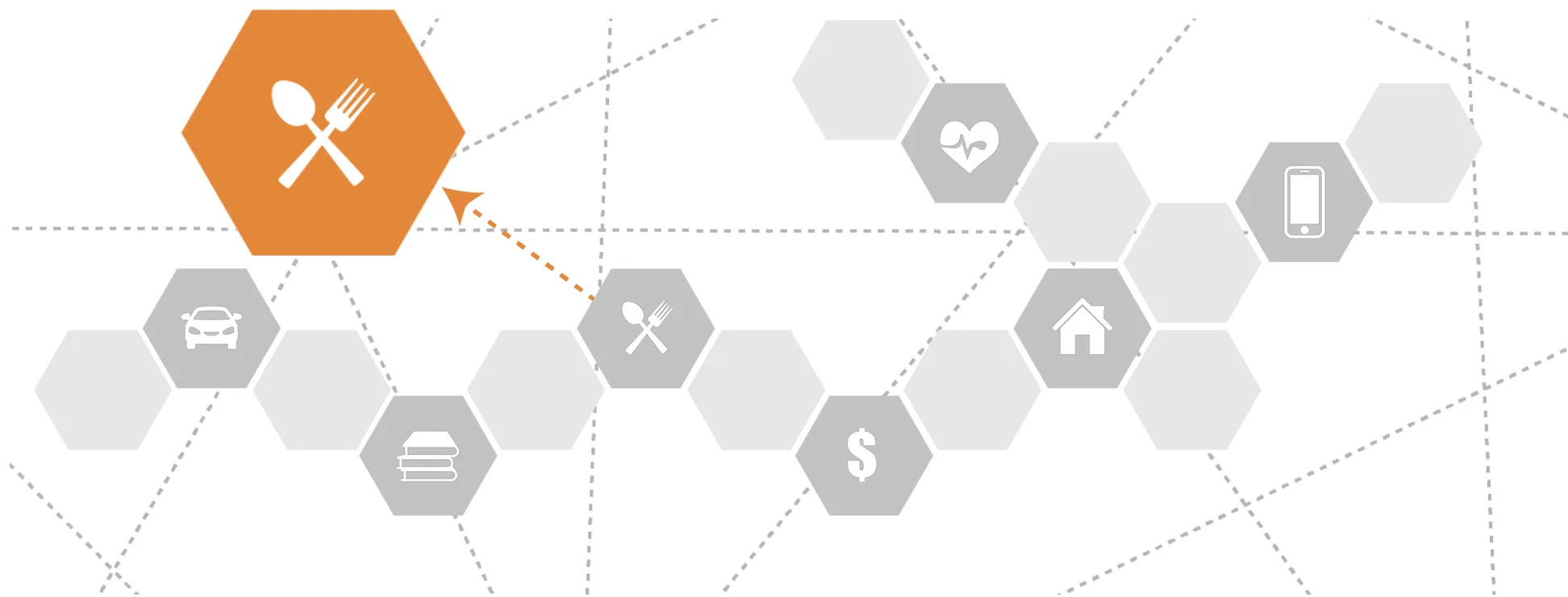
|
Housingclick to view |

|
Health Careclick to view |

|
Child Care and Educationclick to view |

|
Technologyclick to view |

|
Foodclick to view |

|
Taxesclick to view |

|
Transportationclick to view |
||
Broader Costs of Food Insecurity
The lack of sufficient income to afford enough food or healthy food has consequences not only for ALICE’s health, but also for the strength of the local economy and the future health care costs of the wider community:
- Food insecurity impacts schools and workplaces. When children are hungry, they are more likely to have lower academic achievement, more difficulty concentrating, and increased social and behavioral problems, all of which can negatively impact school environments by taxing staff resources and leading to classroom disruption. When adults are hungry in the workplace, they may be less productive and have higher rates of absenteeism.36
- More food-insecure families means higher costs to taxpayers, especially through increased health care spending.37 These costs are borne substantially by Medicare and Medicaid, but also by employers and communities. Adults and children suffering from food insecurity are more likely to have no source of usual health care or to ignore health problems until they become severe. As a result, they are more likely to need hospitalization and to visit emergency rooms.38
Sources
36
RTI International. (2014). Current and prospective scope of Hunger and food security in America. Retrieved from http://www.rti.org/sites/default/files/resources/full_hunger_report_final_07-24-14.pdf
Cook, J., & Jeng, K. (2009). Child food security: The economic impact on our nation. Feeding America. Retrieved from https://www.nokidhungry.org/sites/default/files/child-economy-study.pdf
Hamelin, A.-M., Habicht, J.-P., & Beaudry, M. (1999, February). Food insecurity: Consequences for the household and broader social implications. The Journal of Nutrition, 129(2), 525S–528S. Retrieved from https://academic.oup.com/jn/article/129/2/525S/4731686
37
Berkowitz, S. A., Basu, S., Meigs, J. B., & Selgman, H. K. (2018). Food Insecurity and Health Care Expenditures in the United States, 2011-2013. Health Services Research, 53(3), 1600-1602. Retrieved from https://onlinelibrary.wiley.com/doi/full/10.1111/1475-6773.12730
38
Bhargava, V., & Lee, J. S. (2016). Food insecurity and health care utilization among older adults in the United States. Journal of Nutrition in Gerontology and Geriatrics, 35(3), 177–192. https://www.ncbi.nlm.nih.gov/pubmed/27559853
Berkowitz, S. A., Basu, S., Meigs, J. B., & Seligman, H. (2017). Food insecurity and health care expenditures in the United States, 2011– 2013. Health Services Research. http://www.rootcausecoalition.org/wp-content/uploads/2017/12/Food-Insecurity-and-Health-Care-Expenditures.pdf
Cook, J. T., & Poblacion, A. P. (2016). Appendix 2: Estimating the Health-Related Costs of Food Insecurity and Hunger. In The Nourishing Effect: Ending Hunger, Improving Health, Reducing Inequality (2016 Hunger Report). Washington, DC: Bread for the World Institute. https://www.bread.org/sites/default/files/downloads/cost_of_hunger_study.pdf
FRAC. (2017). The Impact of Poverty, Food Insecurity, and Poor Nutrition on Health and Well-Being http://frac.org/wp-content/uploads/hunger-health-impact-poverty-food-insecurity-health-well-being.pdf

